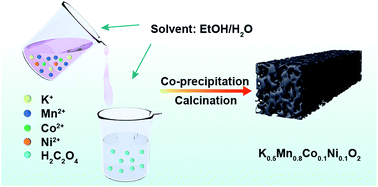A high-performance cathode for potassium-ion batteries based on uniform P3-type K0.5Mn0.8Co0.1Ni0.1O2 porous microcuboids†
Abstract
Layered transition-metal oxides have attracted intensive attention as advanced cathode materials of potassium-ion batteries (PIBs). Nevertheless, their practical application in PIBs is hindered by the unsatisfactory cycling stability and rate capability. Herein, we successfully prepared uniform P3-type K0.5Mn0.8Co0.1Ni0.1O2 porous microcuboids (c-KMCNO) through a low-cost ethanol mediated coprecipitation strategy. The unique porous microcuboid structure considerably reduces the K+ diffusion distance and relieves internal strain caused by continuous K+ intercalation/deintercalation, thus improving the reaction kinetics and architectural integrity to boost the cycling stability and rate performance of c-KMCNO. As a cathode material for PIBs, c-KMCNO delivers a high reversible capacity of 94.5 mA h g−1 at 20 mA g−1, excellent rate capability of 49.5 mA h g−1 at 500 mA g−1, and remarkable cycling stability with a well-retained morphology at 100 mA g−1 after 300 cycles. Furthermore, a K-ion full cell of c-KMCNO//soft carbon demonstrates a reversible capacity of 54.3 mA h g−1 at 100 mA g−1 with a decent capacity retention of 81.1% over 100 cycles. Therefore, this porous microcuboid material demonstrates potential applications as a high-performance low-cost cathode material for PIBs.

- This article is part of the themed collection: Journal of Materials Chemistry A HOT Papers


 Please wait while we load your content...
Please wait while we load your content...